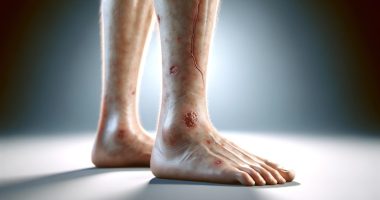Hand tendon injury
Definition
Hand tendon injuries usually result from an open injury (cut wound, hand, fingers caught in moving machinery, etc.). Much less commonly, damage to the tendons of the hand (extensors) occurs due to a closed injury. In any injury to the hand’s tendons, the physician’s main task is to restore the function of the fingers fully and adequately. A clean wound and early treatment of the patient to the traumatologist (up to 24 hours from the moment of injury) allow the application of a primary suture to the tendon. Late treatment, multiple injuries to the hand tissues, and significant contamination of the wound require delayed suturing of the tendon.
Anatomy
A tendon is a dense, inelastic part of a muscle that attaches the muscle to the bone. When the muscle contracts, the tendon “pulls” the bone behind it and allows movement. Disruption of tendon integrity leads to loss of a particular motor function (flexion or extension of a limb segment).
Two groups of tendons provide movement of the fingers: the flexors, located on the palmar surface, and the extensors, located on the back of the fingers. Damage to the flexor tendons is more common and more difficult to treat. Each finger is flexed by two flexors (superficial and deep). The deep flexor is attached to the nail phalanx and is responsible for its flexion. The superficial flexor attaches to the middle phalanx, forming two legs between which the tendon of the deep flexor runs.
The flexor tendons are under considerable tension. When the integrity of the flexor tendon is compromised, the proximal (closer to the center) end is pulled up by the muscle and can be found at a considerable distance from the site of injury. Difficulty finding the proximal end of the tendon and tension of the damaged ends of the flexor tendon causes the complexity of the surgical intervention and possible failure of flexor tendons in the postoperative period. The extensor tendon does not displace much when ruptured, and its proximal end is usually found close to the injury site.
Symptoms and treatment
Clinical manifestations and treatment tactics in hand tendon injuries depend on the localization of the wound, its contamination, and the degree of soft tissue damage. If the wound is clean and smooth (usually incised) and the soft tissues of the hand are well nourished (no concomitant arterial damage), primary suturing of the tendon is performed. The earlier the operation is performed, the higher the chances for good wound healing and restoration of tendon function. The optimal time for surgery is within the first 6 hours after injury. The deadline for a primary tendon suture is 24 hours from the time of injury.
In traumatology, restoring finger function in hand tendon injuries is a complex surgical procedure often requiring microsurgical techniques. The operation is performed under a tourniquet, with minimal traumatization of tissues, under local or conduction anesthesia (so that the patient can flex the fingers on command during the check of tendon restoration). In the postoperative period, the hand is fixed with a plaster cast.
For hand tendon injuries, delayed secondary suturing of the tendon is performed as soon as possible after complete wound healing in case of extensive soft tissue injuries (lacerations, crushing, etc.), significant contamination of the wound, and late referral to a traumatologist.
Isolated injury to the deep flexor tendon. It occurs only when injured in the area of the nail phalanx. The patient cannot flex the joint between the nail phalanx and the middle phalanx. The tendon is sutured if the proximal end of the deep flexor tendon is found during surgery. If the proximal end cannot be found, the peripheral end of the flexor is sutured to the bone of the middle phalanx.
Isolated injury to the superficial flexor tendon. Occurs with wounds to the fingers (excluding the nail phalanx), injuries to the palmar surface of the hand at any level, and wounds to the lower third of the forearm. The patient cannot bend the joint between the middle and main phalanges. During surgery, the proximal end of the tendon is found. If necessary, an additional incision is made in the palm, through which the central end of the tendon is brought into the peripheral wound with a guide.
If the ends of the tendon are crushed or unraveled, they are excised. To prevent postoperative flexion contracture, tendon lengthening in the tendon-muscle part or Z-shaped tendon lengthening proximal to the area of injury is performed. In wounds in the middle and main phalanges of the fingers and, especially often, in the palm, there is simultaneous damage to the deep and superficial flexors.
Damage to both flexor tendons. No flexion in the proximal and distal interphalangeal joints. Only the tendons of the deep flexor tendon are repaired. The ends of the tendons of the superficial flexors are excised. In wounds of the lower third of the forearm, damage to the flexor tendons is often combined with violation of the integrity of veins, ulnar and median nerves, ulnar and radial artery, and tendons of the radial and ulnar flexors of the hand.
Extensor tendon injury. If the integrity of the extensor tendon is compromised due to an open injury (wound), the ends of the tendon are sutured. No surgical intervention is required in the case of subcutaneous extensor tendon rupture within the first three weeks after the injury. The finger is brought to the overextension position and fixed with a plaster cast for six weeks.
All these treatment options are available in more than 800 hospitals worldwide (https://doctor.global/results/diseases/hand-tendon-injury). For example, Hand tendon surgery can be performed in these countries at following approximate prices:
Turkey $1,177 in 32 clinics
Germany $5,141 in 40 clinics
United States $6,427 in 19 clinics
China $6,598 in 6 clinics
Israel $7,826 in 16 clinics.

